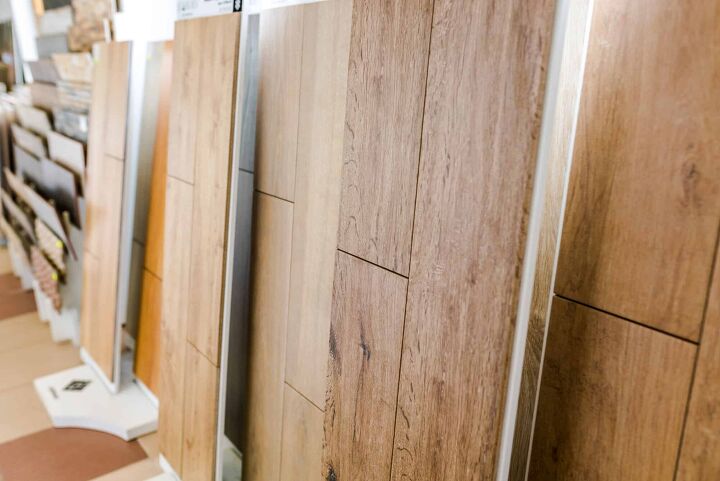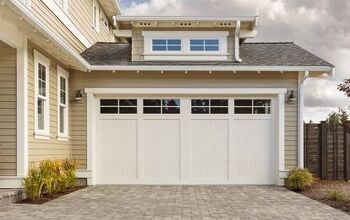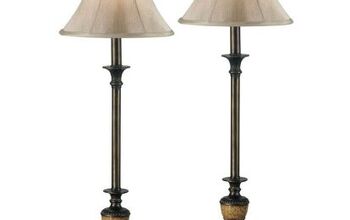Different Types of Laminate Flooring (with Photos)

Laminate flooring is one of the most visually appealing types of flooring that can be installed at a relatively budget-friendly price. In fact, many consider it to be the next big trend in the design world, as it is manufactured to mimic tile, stone, and even traditional wood flooring. It can help you achieve the same look as tile, stone, or wood, at a much lower price and without all the maintenance.
When you’re out shopping for new laminate flooring, you might fight yourself overwhelmed by the amount of options to choose from. For even the most experienced buyers, it can be challenging to sift through the various laminate flooring characteristics, such as thickness, AC rating, installation types, and additional features.
Then, throw in all the decisions you’ll need to make based on color, texture, and finish and you’ll probably be stuck. With so many types of laminate flooring to choose from, how do you choose one that’s best suited for your needs?
Fortunately, we’re here to help! Continue reading for our comprehensive guide on all the different factors that you’ll need to consider to make an informed decision on which laminate flooring type is right for you, your family, and your home.
Do You Need Laminate Wood or Stone Flooring Installers?
Get free, zero-commitment quotes from pro contractors near you.

What is Laminate Flooring?
Laminate is a low-cost alternative to natural wood flooring. It features a highly realistic image layer that is designed to imitate real wood planks, or even other materials like stone, tile, and even metal. Made out of several layers of material, laminate forms a durable, firm type of flooring. Laminate flooring is a popular choice for covering homes’ kitchens, living areas, bedrooms, hallways, bedrooms, and other areas that are not susceptible to excessive moisture.
This type of flooring was developed in 1977 by Perstorp, a Swedish company. Although laminate is known for being an inexpensive, functional flooring alternative. However, these types of floors have slowly moved into higher-end homes as well. In fact, laminate flooring looks better, feels better underfoot, and performs better than the original design.
Layers of Laminate Flooring
In most cases, laminate flooring consists of at least four layers:
- Wear Layer: This layer provides protection for the flooring from dents, staining, and scratches. It also gives the water-resistance required for everyday spills. The wear layer is typically embossed with a texture, while most are “Embossed in Register.” This means that the textures are matched with the decorative layer to create a realistic, wood-like flooring.
- Decorative Layer: The decorative, or image, layer is what contains the print or pattern. This layer is responsible for making the laminate appear like real wood, or whatever material it mimics. The decorative layer may include knots, rough, natural-looking scrapes, or anything else to make it appear like the real deal.
- Core Layer: This layer, made out of compressed medium-density fiberboard (HDF), is what gives the flooring stability and durability. Although the core layer can resist water, it isn’t necessarily waterproof.
- Backing Layer: This layer serves as the base of the laminate, further helping to provide stability for the flooring. It also works to keep water from seeping into the laminate from underneath.
Laminate Flooring Production Process
The core layer of laminate flooring is made out of wood fibers that are compressed through a high-pressure process. This compression process is what makes the floor resistant to the shock of localized impact, such as falling objects or high-heeled shoes. Generally speaking, the higher the pressure is when producing the core, the more durable your laminate flooring will be.
With that said, laminated flooring is produced in two distinct ways: high pressure and direct pressure. To determine which type of laminate flooring you should choose, you’ll want to consider the amount of foot traffic your floors will be exposed to.
- High-Pressure Laminate (HPL) is created using over 1000 pounds of pressure, making it the ideal choice for areas that see high amounts of foot traffic.
- Direct Pressure Laminate (DPL) is created using between 300 and 500 pounds of pressure. While still incredibly durable, this type of laminate flooring is best suited for areas that experience lower amounts of foot traffic, such as homes and small offices. For most residential applications, this is the type to go with.
Laminate Flooring Installation Types
Another way that you can describe the types of laminate flooring is by looking at the ways in which they are installed. This categorization is especially important to consider if you plan on DIYing the install of your laminate flooring, as you’ll want to select an installation method that you prefer.
The following are the different laminate flooring installation types you’ll come across:
- Glueless-Click Laminate Flooring: This type of laminate flooring involves tiles or planks that don’t require glue to install. Roughly two-thirds of the laminate on the market today falls under this easy-to-install, glueless click-lock method (more on locking systems below).
- Glued Laminate Flooring: This installation type requires glue to affix the joints together. Glued laminate actually was the very first generation of laminate flooring. Although it’s not popular anymore today, you may come across this type if you have to remove old laminate.
- Pre-Glued Laminate Flooring: Instead of applying the glue separately, these laminate planks come with the glue already applied. That way, you can simply snap and lock the planks into position. However, some edges may require dampening to activate the glue so make sure that you check the instructions carefully.
Some laminate flooring comes with the underlayment already attached, which makes installation even faster and easier. Without a pre-attached underlayment, you’ll likely have to place one prior to the install to provide sound absorption and cushion underfoot.
In areas that are on or below grade, or places that are susceptible to moisture, you may also have to place a moisture (vapor) barrier before the underlayment.
Laminate Flooring Locking Systems
Fortunately, most modern laminate flooring uses a snap-and-lock installation process, eliminating the need for nails or glue. All you have to do is firmly snap each plank into place to create a floating floor. While most manufacturers have their own patented technology with regard to locking systems, they can be divided into two main categories:
1. Tongue and Groove
Tongue and groove locking systems are the most popular type of laminate flooring and are incredibly easy to install. This system involves each of the laminate planks being fitted with a protruding (tongue) and a concave (groove) piece that fits together similar to puzzle pieces. All four sides will have tongues and grooves.
One tongue fits firmly in the groove of the adjoining board, snapping and locking the planks together. By doing this, vertical movement between boards is controlled. It also allows horizontal movement to a small degree, which is desired as the flooring will expand and contract over time.
2. Mechanical
A variation on traditional tongue and groove, the mechanical type incorporates aluminum mechanical locking systems underneath the planks to hold them together.
Laminate Flooring AC Rating
The Abrasion Criteria (AC) rating is a valuable tool for determining the durability of laminate flooring. Use AC rating to evaluate your expected foot traffic against what the flooring you choose is designed to withstand. This rating is based on a scale of one to five, five being the highest:
- AC1 Moderate Residential. Designed to hold up to only light residential use, making it ideal for bedrooms and closets.
- AC2 General Residential. Designed to handle moderate foot traffic, making it ideal for residential areas that don’t experience a heavy amount of wear and tear such as living rooms and dining rooms.
- AC3 Heavy Residential & Moderate Commercial. This rating indicates the flooring is designed for all types of residential looks including high-traffic areas and even commercial spaces that see light foot traffic.
- AC4 General Commercial. Built to handle any and all kinds of residential situations, including the more heavily trafficked commercial areas with off-street traffic, such as cafes, offices, and boutique stores.
- AC5 Heavy Commercial. This rating indicates that the flooring is designed to withstand the busiest commercial and high-traffic spaces such as government buildings and department stores.
Generally speaking, the higher the AC rating, the higher the price tag on the laminate flooring.
Laminate Flooring Thickness
Another key characteristic in distinguishing laminate flooring types is thickness, typically measured in millimeters (mm). Laminate flooring ranges in thickness from 6mm to 12mm, with the most popular being 7mm, 8mm, 10mm, and 12mm. The thicker the plank, the more it’s going to cost you, but it also doesn’t necessarily mean you’re getting higher quality.
As a general rule of thumb, the more stable the subfloor, the thinner laminate you’ll need. Whereas thicker laminate is ideal for areas where the subfloor is slightly uneven, made of wood, or sound is a factor. Here’s a quick list of the different laminate thicknesses available, in millimeters and converted to inches for convenience:
- 6mm = 1/4″
- 7mm = 9/32″
- 8mm = 5/16″
- 10mm = 7/16″
- 12mm = 1/2″
6mm Laminate Flooring
This is the thinnest type of laminate flooring on the market. Since it is thin, it’s not as durable as other options. However, it can have a surprisingly long lifespan when installed over a strong subfloor like concrete. However, always check the AC rating to ensure that it meets your specific needs.
7mm Laminate Flooring
Slightly thicker than 6mm, the 7mm laminate flooring also needs to be installed over top of a quality subfloor to yield a durable floor.
8-12mm Laminate Flooring
These thicknesses tend to be the most popular since they last longer and provide ample stability. It also resists bending and feels much more like real hardwood flooring. Although just the 8mm thickness is typically enough to satisfy most people’s requirements, some opt for a thicker option to create a sleeker and sturdier laminate flooring.
Laminate Flooring Texture/ Finish
One of the major benefits of laminate flooring is looks, as it’s designed to resemble a variety of materials. A certain amount of texture is applied to the planks in order to achieve the desired look – whether it’s rustic or authentic.
When you’re deciding which type of laminate flooring to go with based on texture or finish, you have a number of options to choose from:
1. Smooth Laminate Flooring
A relatively plain finish that offers a subtle shiny appearance, similar to a layer of varnish you’d see on hardwood. It reflects some light but isn’t overpowering. Oftentimes, you can choose between high, medium, and low gloss finishes.
2. Matte Laminate Flooring
This is one of the most popular textures, as it mimics the natural wood texture of real hardwood flooring.
3. Embossed Laminate Flooring
Some laminate comes with an embossed, or textured finish. Although this isn’t an exact match to the grooves found in the printed grain, it tricks the eye into perceiving surface grain.
4. Distressed Laminate Flooring
Distressed, or hand-scraped laminate adds an antique look that makes it appear like it’s an authentic hand-scraped wood floor.
5. Soft Scraped Finish
This involves a design and a subtle, timeworn finish.
6. Oiled Wood Finish
Laminate flooring with an oiled wood finish is a traditional style that is very popular among buyers today. It resembles natural, untreated hardwood flooring, providing the appearance that the floors were treated with natural oils.
7. High Gloss Finish
High gloss, or piano finish, offers a shiny, sophisticated aesthetic. This finish is ideal for modern, upscale interiors.
8. Oxide Surface Finish
This is a metallic finish that offers a slight bit of shine, ideal for contemporary, chic designs.
9. Slate / Stone Finish
This finish mimics the look and feel of traditional slate or natural stone.
Width of Laminate Flooring Boards
The width of the individual laminate flooring boards makes a huge difference in the overall look of a room. As such, the size of the planks is another major consideration that must be made when you’re deciding which type of laminate flooring to choose.
Most traditional hardwood floors have skinnier boards, while wider planks appear more rustic and modern. Some of the most common laminate flooring board widths include:
- Three to four inches: These are the thinnest options, which can make a small room appear larger.
- Five to six-inch: Slightly wider, these laminate boards are the most common options on the market. They come in a range of patterns and styles to fit virtually any type of décor.
- Wider than six inches: Larger laminate widths are typically wide planks or tiles. These look best in larger spaces.
- Multi-Width: Multi-width boards are commonly used for barn- or reclaimed-wood looks. They are increasing in popularity as a way to add unique dimensions to rooms.
Laminate Flooring Edge Types
Laminate flooring can also be distinguished based on edge type, or how the planks are cut. The edge type will determine how the planks look together – whether they have a defined edge or float seamlessly.
1. Square Edge Laminate
Square edge laminate are planks that do not have a bevel, offering a seamless look when installed.
2. Micro-Bevel Laminate
These planks feature a very fine micro-bevel or rounded corner.
Do You Need Laminate Wood or Stone Flooring Installers?
Get free, zero-commitment quotes from pro contractors near you.

3. Bevel Laminate
Bevel planks have a unique grooved, defined edge – similar to a V shape.
4. Rolled Bevel Laminate
This involves both the design and color, rolling over or continuing past the edge. There are no sharp edges, which yields a more authentic look.
5. Painted Bevel Laminate
These plank edges are painted along the groove, offering a more pronounced appearance.

Jessica considers herself a home improvement and design enthusiast. She grew up surrounded by constant home improvement projects and owes most of what she knows to helping her dad renovate her childhood home. Being a Los Angeles resident, Jessica spends a lot of her time looking for her next DIY project and sharing her love for home design.
More by Jessica Stone











































